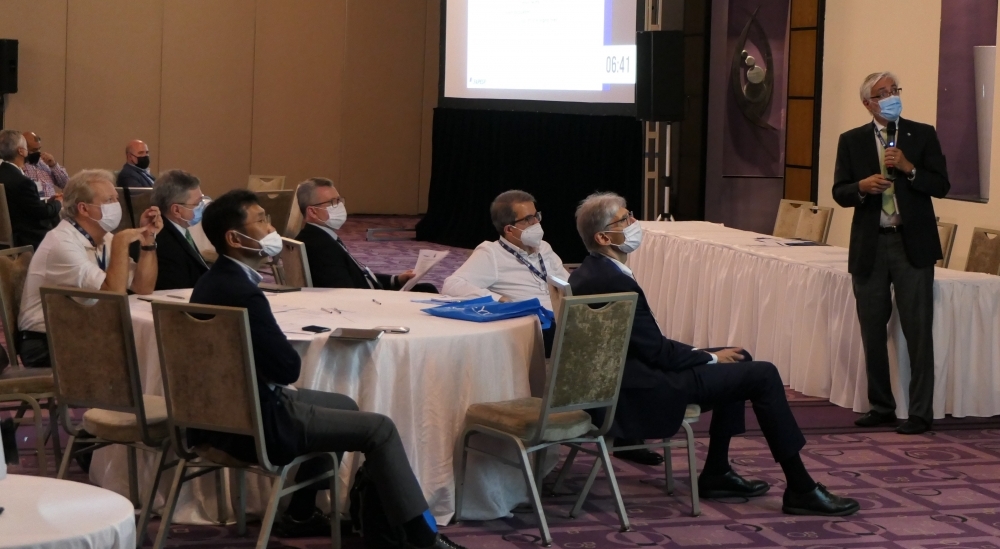


The workshop was a side event to the Annual Meeting of the Global Research Council. The need to dialogue with and learn from traditional communities, especially Indigenous peoples, was emphasized in the discussions (Luiz Eugênio Mello, FAPESP’s Scientific Director, during the event; photo: Jörg Schneider/DFG)
Published on 06/13/2022
By José Tadeu Arantes | Agência FAPESP – The Amazon is a key nexus of Earth’s climate and biodiversity. Its importance and complexity transcend national borders, requiring action to be taken by cross-border collaboration. Interdisciplinary, multidisciplinary and transdisciplinary research projects need funding to produce solutions capable of responding to the daunting challenges it poses. The results already obtained need to be synthesized, and efforts are required to identify knowledge gaps and implementation bottlenecks.
These issues were discussed at a workshop entitled “How can research and research councils contribute to sustainable development of the Amazon region?”, held in person and online on May 30 as a side event to the Annual Meeting of the Global Research Council (GRC), which took place between May 31 and June 3 in Panama City.
FAPESP co-hosted the event, which was attended in person by FAPESP’s CEO, Carlos Américo Pacheco, and its Scientific Director, Luiz Eugênio Mello, with assistants; and remotely by Carlos Alfredo Joly, a member of the steering committee for the FAPESP Research Program on Biodiversity Characterization, Conservation, Restoration and Sustainable Use (BIOTA); Marie-Anne Van Sluys, a member of both FAPESP’s Adjunct Panel for Special Programs and Research Collaborations and the steering committee for its Program for the Encouragement of Scientific Journalism; and Bruna Arenque Musa, Manager, Science Programs.
The purpose of the workshop was to connect agencies that fund research in the Amazon region or plan to do so, including United Kingdom Research and Innovation (UKRI), the German Research Foundation (DFG), the Dutch Research Council (NWO), and the National Natural Science Foundation of China (NFSC), all of which took part in the meeting.
It was opened virtually by Anita Hardon, a member of NWO’s Executive Board, and began with a presentation by Mello on the Amazon and the research done in the region. “Many studies have been conducted in recent decades, but we must connect the dots,” he said, stressing the need for “transdisciplinary projects that take into account priorities set by local actors”.
The Amazon contains 67% of the world’s remaining tropical forest, and accounts for 20% of the freshwater that flows into the oceans and 17% of global photosynthesis. It holds 120 billion metric tons of carbon, equivalent to the amount emitted by burning fossil fuels for some ten years. It releases huge amounts of water vapor into the atmosphere, regulating the local, regional and planetary climate, and its aquatic and terrestrial ecosystems are extremely rich in biodiversity.
If the current predatory or unsustainable development model imposed on the Amazon is not replaced, the region could rapidly collapse. Mining, logging, cattle ranching, crop farming, hydropower dams, oil and gas production and disorderly urban expansion are drivers of destruction. The region has lost almost 20% of its original forest cover in the last four decades. In a period of just one year, between August 2020 and July 2021, more than 13,000 km² was deforested. A similar area may have been affected by forest degradation.
As deforestation advances, human contact with pathogens (viruses, bacteria and fungi) in areas that were once intact becomes increasingly likely, boosting the threat of new pandemics. Several viruses have migrated from tropical forests in Africa and Asia to inhabited areas in response to pressure from land use change.
FAPESP has so far allocated BRL 655 million to more than 3,000 research projects in the region. In November 2021, it launched the Amazon +10 Fund, with an injection of BRL 100 million, and participation by ten states: São Paulo, Acre, Amapá, Amazonas, Maranhão, Mato Grosso, Pará, Rondônia, Roraima and Tocantins. The fund could reach BRL 500 million as it is joined by more governments, companies and international organizations.
A more detailed presentation on the Amazon +10 Fund was delivered by Pacheco, who recalled an oft-neglected fact: Amazonia is not a giant empty space, but home to 47 million people.
The fund has a fourfold remit, Pacheco said: conservation of biodiversity and responding to the climate crisis; protecting populations and traditional communities; addressing urban challenges; and growing the bioeconomy as a development policy for the region.
Breakout groups
Following the more general presentations delivered during the plenary session, breakout groups discussed plans for activities and how to implement them, in particular to strengthen the connections between funders, and to create structures and instruments that encourage and equip researchers to deliver research proposals.
Besides all the criteria that normally apply to research proposals, they will be expected to follow five guidelines: valorizing and incorporating the knowledge and restorative practices of traditional communities, especially Indigenous peoples and local researchers; including local actors in the work of defining the questions to be researched; considering the wellbeing and development of the region’s inhabitants as an expected outcome; networking with other sectors to use research findings to support and inform public policy and private and public investment decisions; and contributing to local research development and infrastructure.
Several groups emphasized the need to dialogue with and learn from traditional communities, especially Indigenous peoples. “Indigenous peoples are experiencing climate change very directly,” said Shaun Baron, International Policy Advisor, Natural Sciences and Engineering Research Council of Canada (NSERC). The existence of so many Indigenous peoples with different languages and cultures should be seen not as a communication problem but as a major learning opportunity, given their cultural diversity.
The event was moderated by Adalberto Val, a senior researcher at the National Institute for Research in the Amazon (INPA). Other participants included Odir Dellagostin, President of Brazil’s National Council of State Research Funding Agencies (CONFAP), and Jorge Cano, Colombia’s Science Minister. Suggestions presented by the breakout groups are bring summarized and systematized and will be made public in due course.
Source: https://agencia.fapesp.br/38880